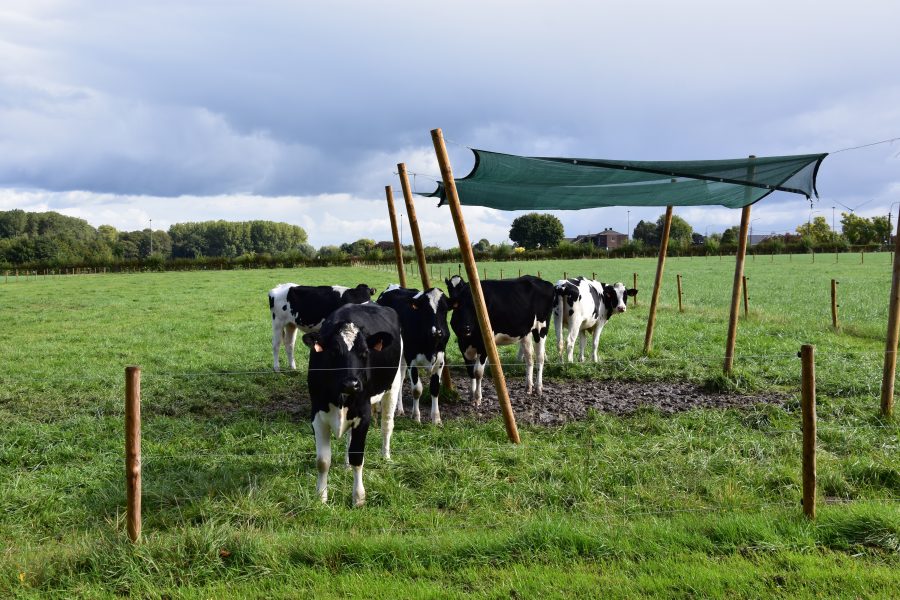General Reed fescue, ideal for grazing young cattle

Climate change is also causing more extreme weather conditions in Flanders. Heavy rainfall in the fall and longer dry periods in the growing season are more common. However, the most commonly used grass for mowing and grazing, English ryegrass (Lolium perenne L.), is sensitive to drought. Dry periods thus jeopardize the production of sufficient quality forage.
Reed fescue
A grass species that performs better in drier periods is reed fescue (Festuca arundinacea Schreb.). This grass is a perennial grass with good persistence and on average 20 to 30% higher dry matter yield compared to ryegrass. Thanks to its deep roots, that extra yield even reaches 45% in dry years. Reed fescue is suitable for mowing and grazing and well resistant to drought and flooding. Due to its slow juvenile growth, the grass is preferably sown in late summer.
After mowing, this grass dries a lot faster than ryegrass. These plots are therefore better mowed last, not shaken, raked last and ensiled first. Reed fescue is well suited for a mixed crop with red and white clover (30 kg/ha + 7 kg/ha red clover + 3 kg/ha white clover) for mowing purposes or only white clover for grazing (30 kg/ha + 5 kg/ha white clover).
The digestibility of reed fescue is on average 10% points lower than ryegrass. Moreover, cattle consume less reed fescue, which makes cattle farmers reluctant to include it the cropping plan.
Trials with reed fescue
In the VLAIO-LA trajectory KLIMGRAS, a collaboration between ILVO and Ghent University, some trials with recent varieties were carried out. These trials show that reed fescue can have added value on a cattle farm. Besides the grazing trials with young cattle discussed below, the incorporation of ensiled reed fescue within a dairy ration was also investigated. These results will be communicated in a subsequent article later in 2024.
In 2021, 2022 and 2023, 4 grazing trials were conducted under different climatic conditions (dry, wet, hot, cold, ...) and during different periods (spring, summer, fall) with pregnant young cattle (Holstein) between 15 and 22 months of age. Small groups of 5 to 7 animals were alternately grazed for 4 weeks on plots of ryegrass or reed fescue that was not previously grazed. Every 2 weeks, all animals were weighed to monitor growth.
In all grazing trials, animals appeared to grow faster on average when grazing on reed fescue (Table 1). In half of the grazing trials, this difference was also significant. During 1 of the 4 grazing trials, methane emissions from the animals on the pasture were also examined. Methane emissions from grazing animals were not found to differ between the two grasses.
Breeders are working hard to develop new varieties of reed fescue with improved digestibility. Despite this effort, there still remains a large gap in digestibility between reed fescue and ryegrass. However, our trials show that these differences are more likely to have a positive effect on growth in grazing young cattle.
Table 1. Daily growth rate of Holstein heifers: Reed fescue vs. ryegrass.
Daily growth rate (kg/animal/day) |
Trial 1 |
Trial 2 |
Trial 3 |
Trial 4 |
Reed fescue |
0,94a |
1,00a |
0,57a |
1,78a |
English ryegrass |
0,63b |
0,66b |
0,46a |
1,46a |
Conclusion
Despite the limited number of animals per trial, the repeatability of the results over the 3 years and under different conditions still clearly shows the added value of reed fescue for grazing young cattle. Indeed, these animals have lower nutritional requirements than lactating dairy cattle and the dry matter intake is less restrictive. In fact, the lower passage rate of reed fescue allows for greater nutrient utilization in reed fescue in these animals.
Grazing pastures for young cattle, as well as beef cattle, can therefore be perfectly sown with reed fescue without negative effects on animal growth or development. The grass supply is higher and more constant throughout the year. More animals can therefore be kept per hectare and there is less need for supplementary feeding. Reed fescue, therefore, does add value on a cattle farm.


